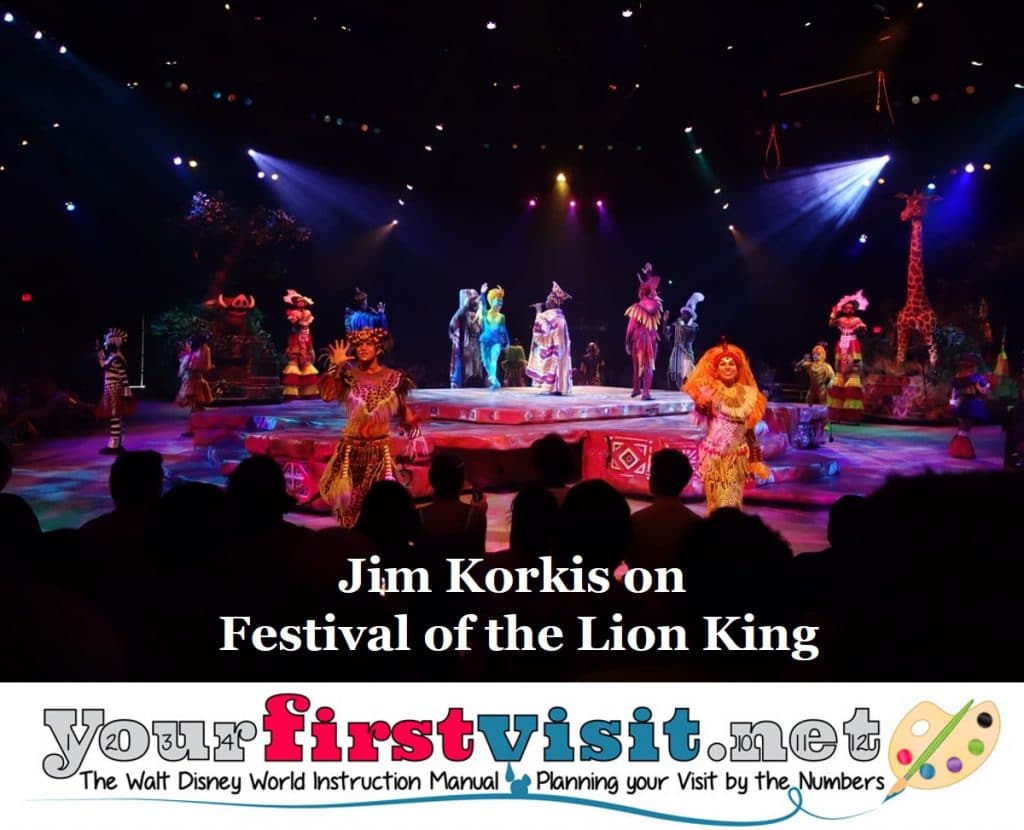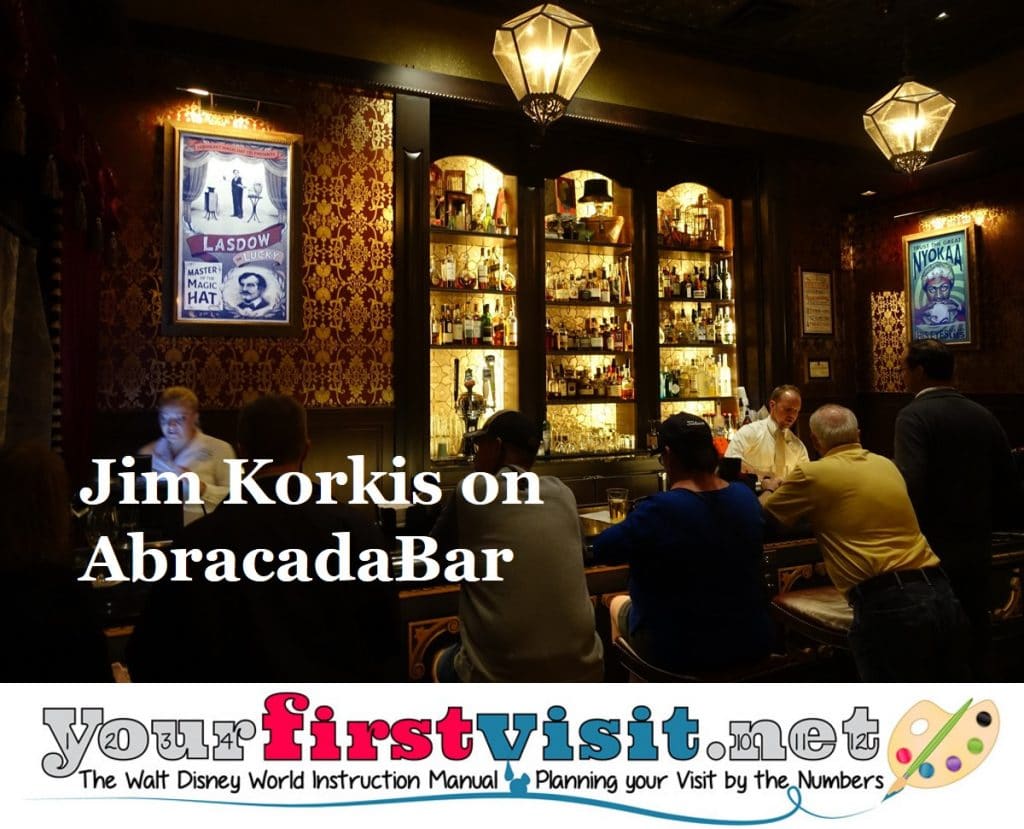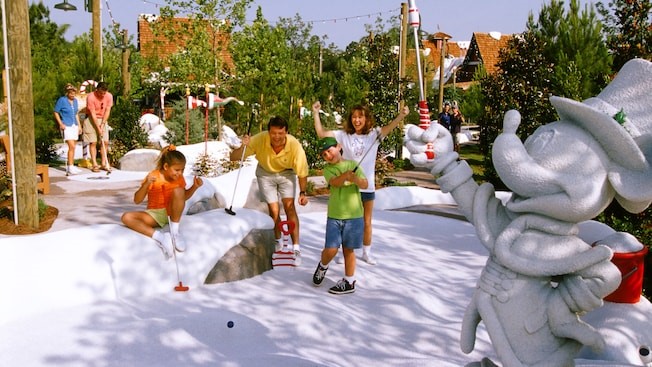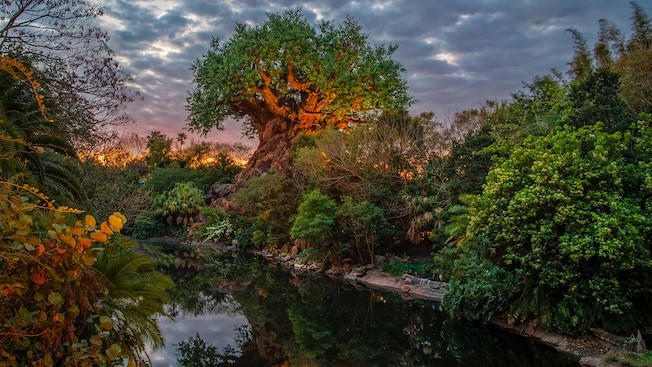Category — A Friday Visit with Jim Korkis
A Friday Visit with Jim Korkis: Disney’s Dinosaurs
Welcome back to Fridays with Jim Korkis! Jim, the dean of Disney historians and author of Jim’s Gems in The easy Guide, writes about Walt Disney World history every Friday on yourfirstvisit.net.
DISNEY’S DINOSAURS
By Jim Korkis
Disney has been bringing audio-animatronics dinosaurs to startling, realistic life since the 1964-65 New York World’s Fair and the primeval world there that Imagineers like Claude Coats created for the Ford Motor Skyway pavilion.
Those prehistoric re-creations were so impressive that they were brought back to Disneyland and installed in 1966 as the finale of the Grand Canyon Diorama tunnel on the Santa Fe & Disneyland Railroad.
However, with new advances in technology, Imagineers wanted to experiment with pushing the boundaries.
While the Animal Kingdom attraction Countdown to Extinction (later renamed DINOSAUR) was loosely inspired by the in-development at the time Walt Disney Feature Animation computer animated feature Dinosaur (2000), the Imagineers had great leeway in developing the time traveling experience and the twenty-one dinosaurs that guests would encounter on the ride.
“We cast it the way, we would cast a movie,” said WDI show producer Anne Malmlund. “You need a hero and you need a villain.”
The villain was the same villain from the movie, a terrifying Carnotaurus which was thirty-three feet long when finally built. A complete skeleton of the prehistoric monster had recently been uncovered in Argentina giving show designer Paul Torrigino a good reference model. However, he was faced with the challenges of what the skin texture might be like or even the color of that skin.
He chose a dusty red, the color of clay, in order to make the animal seem more menacing as well as to contrast it with the lush green Cretaceous forest. A partial skin impression found with the fossil bones showed that the skin seemed to be a rough hide covered with bumps and knobs.
So Torrigino made them bumpier and knobbier because he needed exaggerated features since the vehicles would be moving by so quickly that guests wouldn’t be able to discern any texture at all unless it was highly prominent.
“We wanted to use science and art and drama to create a world our guests could believe in,” Torrigino said.
Imagineers consulted paleontologists, studied countless books and more to make sure the shapes, sizes, movement, skin texture and coloration were as authentic, and dramatic, as possible. Even Imagineer Joe Rohde would drop by to offer his suggestions.
Tujunga’s Plastic shop in California developed a new combination of silicone and spandex that enhanced the lifelike look and movement of the dinosaurs for the attraction.
The new system of skin-on-plates, modeled on human ribs, made the dinosaur movement more fluid and believable. The industrial strength snaps on the skin hook onto bands of metal that are the foundational structure of the animal which included a new underlying armature. The heavy skin could weigh up to 500 pounds.
The Imagineers first mocked up the movement on computers. A small model raptor was then built to test these ideas and it contained powerful new chips to control a range of subtle movements.
These figures included some of the largest audio-animatronics figures ever produced. The heads of the Iguanodon and Saltasaurus were so huge that they scraped the tops of the ceiling of the cavernous warehouse in Tujunga, California where they were built.
It took eight to ten hours of programming for every second of animation per dinosaur. Each dinosaur represented about 14,000 hours of effort by WDI or roughly seven years.
At the first formal review and with appropriate dramatic lighting, CEO Michael Eisner who worried about the investment of time and money was visibly moved. “It’s the first time I’ve been sorry they are extinct,” he said.
* * * * *
Thanks, Jim! And come back next Friday for more from Jim Korkis!
In the meantime, check out his books, including Secret Stories of Walt Disney World: Things You Never You Never Knew, which reprints much material first written for this site, and The Vault of Walt: Volume 4, and his contributions to The easy Guide to Your Walt Disney World Visit, all published by Theme Park Press.
Follow yourfirstvisit.net on Facebook or Google+ or Twitter or Pinterest!!
March 24, 2017 No Comments
A Friday Visit with Jim Korkis: The Festival of the Lion King
Welcome back to Fridays with Jim Korkis! Jim, the dean of Disney historians and author of Jim’s Gems in The easy Guide, writes about Walt Disney World history every Friday on yourfirstvisit.net.
THE FESTIVAL OF THE LION KING
By Jim Korkis
Because of the construction of the upcoming Pandora: The World of Avatar (to open May 27. 2017), the Festival of the Lion King stage show was relocated from Camp Minnie-Mickey where it premiered April 22, 1998 to the new Harambe Theater in the Africa section of Disney’s Animal Kingdom beginning June 2014.

In order to accommodate the number of performances, there are three full casts, plus understudies, and all of them must be brought up to speed periodically with paid “pick up” rehearsals during the year to keep the show sharp. In addition, there is the large behind-the-scenes technical staff handling costuming, lighting, props, sound, and more.
The Festival of the Lion King was a last-minute placeholder for an area that itself was a last-minute addition when plans for a Beastly Kingdom section for the park were halted. Putting on a temporary show was cheaper than investing in building a ride attraction, quicker to create, and was also easier to change once a decision was made about exactly what the area should be.
Since its premiere in 1998, this joyous celebration has become the longest-running stage show at Disney’s Animal Kingdom with enthusiastic guests returning multiple times. The show was designed by Walt Disney World Creative Entertainment, but the performance venue was created by Walt Disney Imagineering.
The theater environment suggests an African savannah where an extraordinary group of humans and animals adorned in decorative feathers and ornate beads on 136 costumes have gathered to present a musical revue.
The action-packed The Festival of the Lion King is hosted by four human performers with Swahili names attired as traditional African tribal leaders: Kiume (“masculine and strong”), Nakawa (“good-looking”), Kibibi (“princess”), and Zawadi (“the gift”). They instruct the guests on how to participate with the performers several times during the show.
It wouldn’t be a true party without some of the cast from the original film! A twelve-foot-high animated Simba stands on Pride Rock keeping time to the pounding rhythm with his feet while interacting with the audience.
Lovable Pumbaa claims his tiny feet keep him confined to the massive Warthog float. However, his companion Timon gleefully struts to the center platform leading the audience in a vocal competition during the song The Lion Sleep Tonight. Since the beginning of 2009, Timon has sported an articulated head that allows his mouth to move when he is talking and his eyes to blink.
The impressive floats that serve as intriguing set pieces are actually recycled from The Lion King Celebration parade that ran at Disneyland from 1994-1997.
Along with performers in African tribal robes and various animal costumes, the center stage spotlights several specialty acts, include a group of zany, bouncing acrobats, tribal stilt walkers precariously navigating the area, a death defying fire juggler and a breathtaking high wire aerialist who soars high above the audience. Each increasingly amazing routine is choreographed to a memorable song from the classic movie.
A beloved audience favorite is the flexible gymnasts in yellow-orange skintight costumes called the Tumble Monkeys. These mischievous and energetic creatures wildly swing and flip on the overhead rings and bars as the hapless Timon tries to sing. Their extensive training includes not only the skillful and fast-moving routine itself but insight into how to move and think like a monkey, including grooming audience members in the front row.
* * * * *
Thanks, Jim! And come back next Friday for more from Jim Korkis!
In the meantime, check out his books, including Secret Stories of Walt Disney World: Things You Never You Never Knew, which reprints much material first written for this site, and The Vault of Walt: Volume 4, and his contributions to The easy Guide to Your Walt Disney World Visit, all published by Theme Park Press.
Follow yourfirstvisit.net on Facebook or Google+ or Twitter or Pinterest!!
March 17, 2017 No Comments
A Friday Visit with Jim Korkis: The BoardWalk’s AbracadaBar
Welcome back to Fridays with Jim Korkis! Jim, the dean of Disney historians and author of Jim’s Gems in The easy Guide, writes about Walt Disney World history every Friday on yourfirstvisit.net.
THE STORY OF ABRACADABAR
By Jim Korkis
The AbracadaBar at the BoardWalk opened in July 2016, serving enchanting elixirs and curious concoctions in the location previously occupied by SeaShore Sweets.
According to Disney publicity, “This little lounge was a former stomping ground for the famous magicians, boardwalk illusionists, and lovely magician’s assistants of the Golden Age. After a show, prestidigitators would gather to ‘conjure’ up new cocktails, swap magic tips and tricks, and stay up all night attempting to ‘out-charm’ each other with their extraordinary illusions.
“According to BoardWalk lore, it was on just such an evening that every single magician in the lounge vanished into thin air, and was never seen again …”
Now, after sitting vacant for nearly seventy-six years, it is back in operation to the general public.
It was on a Friday the 13th in September 1940 that the mysterious disappearance took place but since this private sophisticated social club was left exactly as it was decades ago the magic still remains strongly intact, and can be seen, heard, and savored in the bar’s signature cocktails including Elixir 13, a mixture of Lucid Absinthe and water that may have helped cause the magicians’ disappearance.
The rich and ornate area is decorated with enchanted ever-changing magic show posters, mystifying mirrors, and vintage props and tricks left behind decades ago including displays of locks and keys, cards, linking rings and magic wands.
Even the wall paper has hidden images of interlocking rings, doves, rabbits, card suits, handcuffs and other magical artifacts.
On one wall is a framed copy of The Boardwalk Bugle newspaper from Wednesday November 13, 1940 telling the official back story:
“The shocking revelations of a secret magicians’ lounge could point to new clues concerning the group of beloved illusionists who mysteriously vanished from our boardwalk weeks ago. Though, truth be told, we may be more perplexed than before.
“A custodian working at BoardWalk’s magic club made the surprising discovery late yesterday evening when he rested his mop against a false door leading into the secret room. By the look of the room’s peculiar décor – including magical accoutrements and shelves lined with curious elixirs – this is no doubt the clandestine hideout of our missing master magicians.
“But there’s just one dilemma…there are still no magicians in sight!
“After investigating the magicians’ hideout this morning, The Boardwalk Bugle noticed something extra out of the ordinary about this already peculiar lounge. Glasses filled with odd elixirs still sat on the countertops.
“Magic props and playing cards were scattered all about. And, stranger yet, all of the clocks in the room were set to thirteen past the hour – almost as if time froze and every magician disappeared on the spot.
“When we questioned the club owner about her knowledge of the hidden room and the possible whereabouts of the missing magicians, she repeated the same unhelpful news we’ve been reporting for weeks now: “A good magician never reveals her secrets!”
“According to multiple witnesses, the missing conjurers in question were last seen entering the loading area behind BoardWalk’s magic club on September 13th. All wore ostentatious costumes, and were accompanied by assistants, stagehands and crates filled with small animals – including doves, rabbits and the like.
“Suspicions only arose when the touring magician Laslow the Lucky failed to appear for his much anticipated matinee performance the following day. In addition to M. Laslow, it would appear that his assistant, multiplying rabbits and every illusionist on the boardwalk vanished along with him.
“Whether a good illusion or a simple misunderstanding, The Boardwalk Bugle will be certain to keep our dear readers informed about the whereabouts of our beloved magicians.”
* * * * *
Thanks, Jim! And come back next Friday for more from Jim Korkis!
In the meantime, check out his books, including Secret Stories of Walt Disney World: Things You Never You Never Knew, which reprints much material first written for this site, and The Vault of Walt: Volume 4, and his contributions to The easy Guide to Your Walt Disney World Visit, all published by Theme Park Press.
Follow yourfirstvisit.net on Facebook or Google+ or Twitter or Pinterest!!
March 10, 2017 No Comments
A Friday Visit with Jim Korkis: Winter Summerland
Welcome back to Fridays with Jim Korkis! Jim, the dean of Disney historians and author of Jim’s Gems in The easy Guide, writes about Walt Disney World history every Friday on yourfirstvisit.net.
WINTER SUMMERLAND GOLF
By Jim Korkis
Opened March 12, 1999, the Winter Summerland miniature golf courses located near the entrance to the Blizzard Beach water park was the second such venue built for Walt Disney World. The first mini-golf course on property was Fantasia Gardens that opened in 1996 near the Swan and Dolphin resorts.
These were built to try to keep guests on WDW property instead of venturing to the popular mini- golf venues that were nearby in the Orlando and Kissimmee.
Established in 1983 in Traverse City, Michigan, the Pirate’s Cove Adventure Golf courses around the country provided elaborate landscaping and distinctive props and the one on State Road 535 just minutes from WDW drew both local and tourist families.
Established in 1978 in Fort Myers Beach, Florida, Jungle Golf also has locations around the country as well as the Orlando area. Congo River mini-golf on International Drive is one of eight locations in Florida that also offers a themed environment.
The back story to Blizzard Beach was that a freak snowstorm in Central Florida led to the creation of Florida’s first and only ski resort. However, that weather did not last long, leaving behind a soggy venue that was converted into a water park using the same infrastructure that had been installed.
According to the Disney publicity release, the mini-golf course was inspired by that same snowstorm.
“Late one moonlit Christmas Eve, as Santa was flying over Florida on his way back to the North Pole, he glanced down and could not believe what he saw. Santa found snow in a place that is usually hot. After surveying the strange location, he decided to build a vacation destination for his off-duty elves — a Winter Summerland.
“The only thing Winter Summerland lacked was a golf course. So the elves divided into two camps, one that enjoyed the warm Florida sun and another that preferred the snow and cold of the North Pole. In this Winter Summerland, the elves built two distinctly different 18-hole golf experiences — a sand course and a snow course.
“Both courses at Winter Summerland are loaded with interactive elements that will entertain and engage golfers of all ages. On the snow course, Squirty the Snowman sprays water on unsuspecting guests when their golf balls pass beneath him. On the sand course, guests putt over a slumbering Santa buried underneath a tremendous sand mound.
“Although the elves were split into different camps, they agreed that the last couple of holes should converge within an old log campground lodge. Upon sinking their last putt on Hole 18, guests journey through cyberspace via the WinterNet as a computer downloads a special greeting from Santa. Winter Summerland also features Santa’s ‘winterbago’, a converted travel trailer that houses the starter booth, and small snack and gift shops.”
Since the courses were designed to be “elf-size’, it means that there are the perfect proportion for younger guests. Merry obstacles include giant peppermints, hockey sticks and the drawbridge of a fantastical, melting castle. Both courses have a replica of Cinderella’s Castle that looks like ice and sand respectively.
Photo opportunities include the ability to sit behind the reins of Santa’s sleigh or gather in front of a surfing Santa statue created by the elves and provides just one more enhancement to this entertaining, and often forgotten, location.
* * * * *
Thanks, Jim! And come back next Friday for more from Jim Korkis!
In the meantime, check out his books, including Secret Stories of Walt Disney World: Things You Never You Never Knew, which reprints much material first written for this site, and The Vault of Walt: Volume 4, and his contributions to The easy Guide to Your Walt Disney World Visit, all published by Theme Park Press.
Follow yourfirstvisit.net on Facebook or Google+ or Twitter or Pinterest!!
March 4, 2017 No Comments
A Friday Visit with Jim Korkis: The Tree of Life
Welcome back to Fridays with Jim Korkis! Jim, the dean of Disney historians and author of Jim’s Gems in The easy Guide, writes about Walt Disney World history every Friday on yourfirstvisit.net.
THE ART OF THE TREE OF LIFE
By Jim Korkis
The Tree of Life, the centerpiece of Disney’s Animal Kingdom, was meant to be a work of art that would be a tribute to mankind’s respect for nature and life on earth.
Eleven sculptors were engaged to work together to bring the artificial icon to life. That team included a sculptor from France (Fabrice Kennel), another from Ireland (Vinnie Byrne), three Native Americans (Parker Boyiddle, Craig Goseyun, Arthur Rowlodge), five Floridians (Eric Kovach, Steve Hunke, Joe Welborn, Gary Bondurant, Jacob Eaddy) and one sculptor from Indianapolis, Indiana (Roger White).
The animal sculpting was supervised by WDI senior show production designer and art director Zsolt Hormay, to keep it all consistent.
“It was really important that the look of the tree flows without any interruption,” Zsolt said. “The sculptors met every morning, studying a pile of wood for reference. They would discuss what each branch should be: a banyan, an emerging oak, a touch of cedar.”
That same pile of wood served as inspiration for the textures of the animals like the stripes on the tiger being banyan bark and the octopus’ skin modeled on oak.
The intent was to carve more than 350 animals into the base and branches and the art was to feature a mixture of styles, with some animals blending in and others standing out with high detail.
“People might look at the trunk and they might think, ‘It’s just brown bark’ but it’s more complicated than that, “said production designer Ron Esposito. “We used 50 to 60 color values to reveal the animals while maintaining naturalism. The tree has a dry side and a wet side, five different moss colors, multiple lichen colors as well as brown tones, overtones, and shadow tones.”
“I feel that we achieved it successfully as far as trying to create a look where the animals were grown by the tree and not just stuck on the surface,” said Zsolt.
To achieve that effect, the artists had to sculpt the animals directly onto the tree, while wearing hard hats, working on scaffolding and immersed in the distracting and loud sounds of a construction site.
“In the beginning, it was a little difficult to get used to creating a sculpture every day and the fact that we just spray the cement on, you form it and by the time the sun goes down, it has to be done,” recalled Zsolt.
Each artist was able to sculpt an animal or two and dedicate it to family members. Zsolt’s daughter wanted him to sculpt a koala for her and so he did. He also did a baboon for his wife and a scorpion for his son.
Zsolt and the other artists found the experience emotionally moving and it helped them to better understand the importance of the tree to communicate to guests the wonder of nature and animals on earth.
“You can find a tree of life in various cultures, going back thousands of years,” stated Zsolt. “To me, it’s really uplifting that we can have a Tree of Life here at Disney’s Animal Kingdom and have it function as an important messenger to the people.”
Someone who ended up having a personal emotional attachment to the structure was famous wildlife researcher Jane Goodall. During the early work on the tree, she walked the site and asked her guide, animal care expert Rick Barongi, where the chimpanzee would be placed.
There had been no plans to include one but Zsolt found one of Goodall’s photographs of David Graybeard, the first chimpanzee to accept Goodall into his society, opening the door for her groundbreaking research. Zsolt and Kennel sculpted the chimpanzee in three days and it is at the entrance to the attraction.
* * * * *
Thanks, Jim! For more on the new nighttime shows at the Tree of Life, see this. And come back next Friday for more from Jim Korkis!
In the meantime, check out his books, including Secret Stories of Walt Disney World: Things You Never You Never Knew, which reprints much material first written for this site, and The Vault of Walt: Volume 4, and his contributions to The easy Guide to Your Walt Disney World Visit, all published by Theme Park Press.
Follow yourfirstvisit.net on Facebook or Google+ or Twitter or Pinterest!!
February 24, 2017 No Comments
A Friday Visit with Jim Korkis: Turkey Legs
Welcome back to Fridays with Jim Korkis! Jim, the dean of Disney historians and author of Jim’s Gems in The easy Guide, writes about Walt Disney World history every Friday on yourfirstvisit.net.
TURKEY LEGS
By Jim Korkis
One of the iconic food treats at Walt Disney World is the infamous, enormous Turkey Legs that made their debut in Frontierland in the late 1980s.
Originally, they were sold at only one food cart location, but the demand grew so large that they expanded to other Disney parks including Disneyland.
Weighing roughly one and half pounds each, the legs have a taste that vaguely resembles ham thanks to being cured in a similar salt and sugar solution. The legs cost up to twelve dollars each.
Each leg is roughly 730 to 1,136 calories with a minimum of 36 to 54 grams of fat, according to the size of the leg. Orginally, Disney sold legs that were 22 ounces but today the “jumbo” leg is closer to 34 ounces.
The Turkey Legs are not unique to Disney and are sold at carnivals, state fairs and other amusement venues around the United States.
A persisent urban myth was that the legs were so huge that they couldn’t possibily be from an actual turkey and must be from another bird like an emu or an ostrich.
“People are accustomed to Thanksgiving turkeys, which are female birds, or hens which are traditionally much smaller; the males, called toms, are bigger — up to fity pounds apiece — and their legs are the ones that Disney serves,” said Keith M. Williams, a vice president at the National Turkey Federation, an industry trade group. Federal law prohibits the use of steroids to make turkeys and their legs meatier. However, farmers are raising larger turkeys because of demand and so the legs are larger as well.
Turkey legs are a favorite food of Andrew Zimmern, host of Travel Channel’s Bizarre Foods:
“With the turkey, I can walk, I can gnaw, I can pull pieces off, I can put it down. And I just love salty, smoky, meaty. … It’s an American classic. It’s Americana.
“I can put everyone’s mind at rest. It can’t be emu. I’ve eaten emu. It’s too big, And the meat would be a little more beefy. Emu has the consistency of turkey leg but the flavor of roasted veal. It’s got mild beefiness to it and a little more metallic.”
In general, an emu leg would be about eight times the size of a turkey leg.
Marc Summers of Food Network’s Unwrapped: Walt Disney World stated,
“Many guests aren’t familiar with smoked poultry, so they pick up on the salty flavor. Disney injects their legs with a salt water cure for moisture, then smoke them. Turkey legs have pink meat because of the six-hour smoking process. It flavors the legs and keeps the inside meat pink and moist.”
The food treat became so popular that in 2010, Disney created a line of merchandise souvenirs including hats, pins, magnets, t-shirts and even air fresheners featuring an image of the item and the slogan “Nice & Juicy!” Disney bakeries even produce Rice Krispie Treat versions with chocolate icing as the skin.
By 2013, it was estimated that in Disney’s North American theme parks over two million of the jumbo turkey legs were sold and consumed each year. Turkey legs are no longer available at Disney’s Animal Kingdom since March 1, 2016.
Disney has stated that the legs are meant to be shared and that the average park visitor walks about seven miles during a visit or enough to burn most of the calories from eating the leg. They state that the popularity of the food item is due to its novelty and its “comfort food” factor.
* * * * *
Thanks, Jim! And come back next Friday for more from Jim Korkis!
In the meantime, check out his books, including Secret Stories of Walt Disney World: Things You Never You Never Knew, which reprints much material first written for this site, and The Vault of Walt: Volume 4, and his contributions to The easy Guide to Your Walt Disney World Visit, all published by Theme Park Press.
Follow yourfirstvisit.net on Facebook or Google+ or Twitter or Pinterest!!
February 17, 2017 1 Comment







